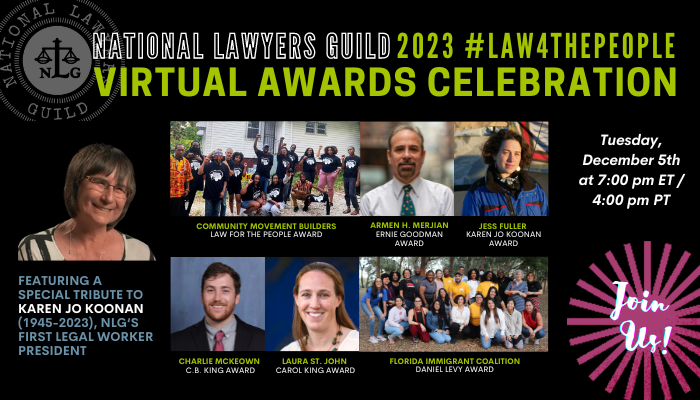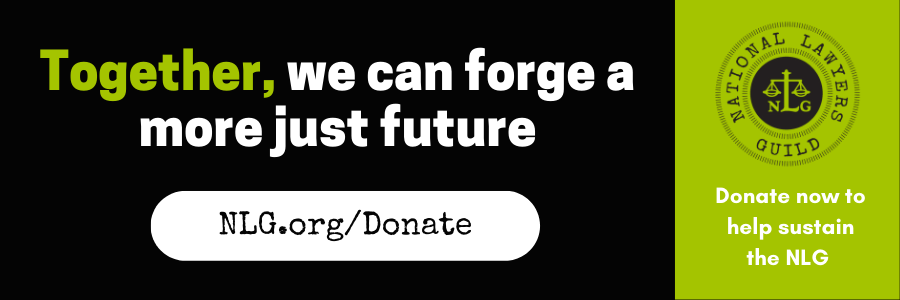Endorsed by the NLG National Executive Council and the NLG Mass Defense Committee
The National Lawyers Guild has put into practice the principles of movement legal work since the organization was founded in 1937. More than 80 years later, NLG membership passed a resolution on Movement Lawyering and Collective Defense in 2021 to formally adopt these principles, and to recognize that movement legal work can be “both client-centered and politically transformative.”
Many definitions have been offered over the years to help us better understand what differentiates movement legal work from the zealous advocacy more commonly practiced in the legal field. One definition of movement legal work that reflects NLG values can be found in a 2017 NYU Clinical Law Review essay by Betty Hung, a member of the Los Angeles NLG chapter:
Lawyering that supports and advances social movements, defined as the building and exercise of collective power, led by the most directly impacted, to achieve systemic institutional and cultural change.
Another definition that reflects NLG values comes from Law for Black Lives:
Movement lawyering means taking direction from directly impacted communities and from organizers, as opposed to imposing our leadership or expertise as legal advocates. It means building the power of the people, not the power of the law.
Yet, the legal work of supporting movements is about more than just “lawyering” and involves more than just lawyers. This work necessitates the engagement of lawyers, legal workers, and often law students, not to mention activist-defendants themselves, which is why we’ve adopted the term “movement legal work.”
It should be evident from the definitions above that movement legal work is about more than just representing activists and zealously defending them in court. What follows is a deeper look at what movement legal work means to the NLG.
Exploring Movement Legal Work
People arrested as a consequence of politically motivated actions often consider themselves part of social movements. They define their goals and strategies in terms of what is likely to protect or advance the welfare of their co-defendants or larger social movements, rather than what is most likely to protect them from individual legal risk or liability. Therefore, movement lawyers and legal workers must endeavor to center the goals of activist-defendants and be willing to help advance their self-determined political interests and strategies, in an effort to build their political power.
One of the most well-known examples of movement legal work in practice is the “Chicago 8” trial. NLG lawyers William Kunstler and Leonard Weinglass worked collectively with their activist-defendants to use the spectacle of a months-long conspiracy trial as an opportunity to advance the movement against the Vietnam War and shine a light on the injustice of the legal system itself. The defendants engaged in a collective defense strategy despite facing criminal conspiracy charges, and they used tactics inside and outside of the courtroom to achieve goals other than lessening their legal harm.
Collective defense is just one of many strategies to advance social movement struggles. However, movement lawyers and legal workers need to consider using collective defense strategies like non-cooperating joint defense agreements, and waiving certain legal conflicts of interest, to the benefit of the movement writ large.
For collective defense to function effectively, lawyers, legal workers, defendants, and sometimes defense committees convened to support activist-defendants, all need to work and strategize together. This can facilitate greater agency and horizontal participation by movement actors in the legal process.
By contrast, the practice of representing activists as wholly separate from their social movements serves the mystification and inaccessibility of the law and legal work, and upholds the status quo where legal technicians hold power over the communities and movements they endeavor to support.
Resistance Lawyering
In his thoughtful and painstakingly researched California Law Review article (2019), legal scholar Daniel Farbman advances the concept of “resistance lawyering,” which fits well with NLG principles of prison and policing abolition. Farbman defines resistance lawyering as lawyers employing “every means at their disposal to frustrate, delay, and dismantle the system within which they [are] practicing.” A relative definition, rather than an absolute one, Farbman describes resistance lawyering as “an attitude toward a set of procedures rather than any fixed political commitment.”
Farbman’s foundational example of resistance lawyering: attorneys who fought the Fugitive Slave Law of 1850, not just by mitigating the worst injustices of that law in order to achieve the best possible outcomes for their clients, but also by resisting, obstructing, and dismantling the system itself. In this context, Farbman uses the word “system” not to describe the law more broadly, but a particular legal regime embedded in it, like slavery or capital punishment.
While the resistance lawyers of the 1850s did not think they were dismantling the institution of chattel slavery in the courtroom, according to Farbman, they saw cases arising from the Fugitive Slave Law as an opportunity to wage a “vigorous rhetorical proxy battle against slavery.” And, while lawyers were not the primary heroes of the story, they were “active and powerful partners in the political resistance to the law.”
Whereas resistance legal work can be defined as a rejection of certain legal regimes, it can be grounded in a fundamental commitment to the law more broadly. Indeed, for legal tactics to effectively achieve a particular outcome, we may not be able to entirely rupture our relationship to the legitimacy of the process or accomplish such outcomes outside the boundaries of legal practice.
Notably, however, some movement lawyers and legal workers, especially within the ranks of the NLG, not only question the legitimacy of specific procedural mechanisms of the law, but the very purpose and structure of the system. Farbman argues that these movement lawyers and legal workers will always be “engaging strategies of resistance because they are using the tools of a system that they consider illegitimate to try to tear that system down.”
Ethics of Movement Legal Work
Lawyers and legal workers who engage in movement legal work use an array of legal tools at their disposal, but do so in a participatory, power-sharing process within the lawyer-client relationship, according to legal scholars Gerald Torres and Lani Guinier. In this way, lawyers and legal workers directly support the production of cultural shifts that make lasting change possible, all within the parameters of legal jurisprudence.
Movement legal work is consistent with and supported by the ABA Model Rules of Professional Conduct. Model Rule 1.2 states that, with few exceptions, “a lawyer shall abide by a client’s decisions concerning the objectives of representation and, as required by Rule 1.4, shall consult with the client as to the means by which they are to be pursued.”
All lawyers have a duty to empower every client to define their own goals, and the Model Rules acknowledge that a client’s goals may go beyond judicial outcomes. While movement lawyers and legal workers should never pressure anyone to engage in collective defense strategies, they have a professional and moral responsibility to openly share information relevant to an individual’s defense, as well as implement a defense strategy—within the bounds of the law—to accomplish the stated goal of a client, who may actually have multiple goals, including advancing movement interests.
Solidarity with co-defendants and consideration for the impact to social movements are legitimate concerns for activist-defendants. For those who want to work collectively, non-cooperating joint defense agreements, grounded in the common interest privilege, can enable activist-defendants to share information without violating or waiving attorney-client privilege. Joint defense agreements can bind the parties from disclosing any privileged information to anyone who is not a party to the agreement.
The notion that an unwaivable conflict arises from joint defense strategies, as some have argued, is contrary to both the Model Rules and the principles of the NLG. Such a position presumes, in the face of countervailing evidence, that political and legal goals are mutually incompatible, and that the goals of one client are necessarily inimical to those of another.
By centering social movement goals and working collectively together, activist-defendants may pursue a variety of legal and/or political strategies and tactics. From the “Chicago 8” example above, activist-defendants may simply want to use their legal case to generate publicity around movement issues and demands.
Activist-defendants and arrestees may want to use their combined leverage to pursue forms of collective bargaining, in which they work together to negotiate plea agreements or terms of release beneficial to everyone, or in which defendants facing less serious charges refuse plea agreements until their more seriously charged co-defendants are offered favorable resolutions.
Activist-defendants who center social movement goals may choose to explicitly oppose aiding the government in the investigation or prosecution of other activists, such as non-cooperating plea agreements, or pursuing trial strategies that don’t identify or blame other activists for illegal activity.
By contrast, activist-defendants who seek to minimize their individual legal liability at the expense of their comrades by directly cooperating in the prosecution of others, or denouncing comrades in the hopes of gaining a mitigated sentence, are not engaging in movement defense strategy, and those who support this approach are not practicing movement legal work.
Some attorneys have raised concerns that their affiliation with a movement-aligned organization may create a conflict of interest prohibiting them from representing movement activists. But in our view, no Model Rule supports that position. We think such arguments are not just misguided; they are dangerous, as prosecutors may exploit them to deny activists their chosen legal counsel.
The Call to Engage in Movement Legal Work
If limitations and biases are inherently part of the law, and if fairness in the legal system is unachievable given deeply embedded structural inequity and oppression, we should help defendants collectivize their resistance in order to create stronger, more emboldened movements. We must consider alternatives to the more traditional models of legal work that embrace those aspects of the legal system designed to atomize and isolate defendants.
In order to practice movement legal work, we must acknowledge and diminish the power imbalances that commonly exist between lawyers, legal workers, and activist-defendants, which may entail intentionally relinquishing certain privileges we’ve gained during our lives, or even ones we were born with.
We must challenge certain assumptions and remove the obstacles preventing us from better meeting the needs of social movements. In doing so, lawyers and legal workers may be called on to engage in deep self-reflection, political analysis, give up power, and genuinely assess the systems within which we work. We may also be called on to learn and implement unfamiliar organizing methods, and to develop skills outside of litigation, all with the aim of integrating our support more explicitly with movement goals in order to magnify the impact of our efforts.
We’re up for the challenge!
In the months and years ahead, the NLG will continue to grapple with these concepts and work to expand the understanding of movement legal work among its membership and the social movements it supports.


